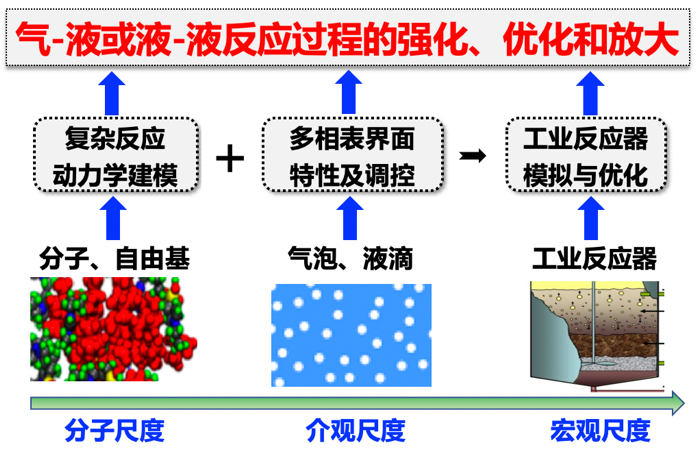孙伟振,教授,博士生导师。
近年来关注化工过程强化、多尺度建模以及纳米材料在化工能源和医学领域的应用。利用化学工程理论和方法研究复杂体系的反应动力学、大型工业反应器设计开发和模拟优化,以及借助分子动力学方法研究原子尺度上多相反应的表界面特性、反应-传递关系及反应机理等。以第一/通讯作者在AIChE J、CES、CEJ、IECR等国际主流化工期刊发表SCI/EI论文40余篇。获上海市技术发明一等奖(2014)、中国石油和化学工业联合会科技进步一等奖(2018)。

教育背景
1999年本科毕业于华东理工大学化工工艺专业,分别于2004年、2009年获华东理工大学化学工程硕士和博士学位。2012年9月至2013年9月在美国加州大学伯克利化工系Berend Smit组从事分子模拟研究。
工作经历
1999~2001年在青岛钢铁集团公司润滑油厂任副厂长。2004年至今在华东理工大学化工学院工作,历任助教、讲师、副教授、教授。
学术任职
Frontiers in Chemical Engineering编辑;美国化学工程师学会(AIChE)高级会员;中国化工学会会员。
研究兴趣

1、化工过程开发
大型工业反应器开发、化工过程强化与优化等,包括(1)气-液反应体系如芳烃(PX、MX)氧化、国防材料聚酰亚胺单体合成等;(2)液-液反应体系如离子液体/硫酸催化C4烷基化合成高品质清洁汽油等;(3)高值精细化学品(日化产品、食品添加剂)的连续化工艺改造等。
2、多相反应表界面性质调控
研究多相反应(液-液、气-液、气-固、气-液-固)表界面上小分子的溶解、扩散、自组织等表界面特性,理解并指导反应过程的强化和催化剂设计。研究对象包括离子液体催化C4烷基化、烃类液相氧化、乙烷氧氯化等。
3、多尺度模拟计算
常规蒙特卡罗(MC)、分子动力学(MD)模拟以及基于反应力场的分子动力学(ReaxFF-MD)模拟(用于研究燃烧、裂解等快反应);复杂反应体系的动力学建模;反应器模拟;化工流程模拟。
4、材料化学工程
可控制备MOF、ZIF、COF等纳米多孔材料,研究其在化工分离、医学杀菌和载药、锂离子电池等方面的应用。合成各类新型离子液体(IL)用于催化反应和医学杀菌。
主持的代表项目
1、离子液体催化烷基化反应液-液两相表界面的介尺度机制及调控,国家自然科学基金重大研究计划培育项目;
2、高性能聚酯与聚酰胺66工业丝高效低碳制备基础研究,十三五国家重点研发计划子课题;
3、超临界甲醇/CO2在纤维素降解中的协同效应,教育部留学回国人员科研启动基金;
4、环己基苯催化氧化制苯酚环己酮小试研究,中国石化;
5、重质芳烃分离制备连苯二酐技术研究,中国石化;
6、大型间苯二甲酸生产装置工艺开发研究,中国石油;
7、羟基吡啶酮类香料工业装置连续化自动化工艺开发研究,爱普香料集团股份有限公司;
8、糠醛反应器技术开发,易高卓新节能技术有限公司
代表性著作
(一)多相表界面
Promoting the Sulfuric Acid Catalyzed Isobutane Alkylation by Quaternary Ammonium Ionic Liquids. AIChE Journal, 2020, 66: e16979.
Towards an Understanding of the Microstructure and Interfacial Properties of the Ionic Liquid/Sulfuric Acid Catalyst in Liquid-Liquid Reactions. Chemical Engineering Science, 2019, 205: 287-298.
Probing Interfacial Behaviors of Brønsted Acidic Ionic Liquids Improved Isobutane Alkylation with C4 Olefin Catalyzed by Sulfuric Acid. Chemical Engineering Journal, 2019, 377: 119744.
Experimental and Modeling Study of Isobutane Alkylation with C4 Olefin Catalyzed by Brønsted Acidic Ionic Liquid/Sulfuric Acid. Chemical Engineering Journal, 2019, 377: 119578.
Understanding Structure-Property Relationship of SO3H-Functionalized Ionic Liquids together with Sulfuric Acid in Catalyzing Isobutane Alkylation with C4 Olefin. Industrial & Engineering Chemistry Research, 2018, 57: 15310-15318.
Microstructures of the Sulfonic Acid-Functionalized Ionic Liquid/Sulfuric Acid and Their Interactions: A Perspective from the Isobutane Alkylation. Journal of Physical Chemistry B, 2018, 122: 1460-1470.
Understanding Interfacial Behaviors of Isobutane Alkylation with C4 Olefin Catalyzed by Sulfuric Acid or Ionic Liquids. AIChE Journal, 2018, 64: 950-960.
Screening of Imidazolium Ionic Liquids for the Isobutane Alkylation Based on Molecular Dynamic Simulation. Chemical Engineering Science, 2018, 183: 115-122.
Modeling of the Interfacial Behaviors for the Isobutane Alkylation with C4 Olefin Using Ionic Liquid as Catalyst. Chemical Engineering Science, 2017, 166: 42-52.
(二)反应动力学、反应器
Multiscale Modeling of Isobutane Alkylation with Mixed C4 Olefins Using Sulfuric Acid as Catalyst. Industrial & Engineering Chemistry Research, 2019, 58: 6340-6349.
Multi-Scale Modeling of Isobutane Alkylation with 2-Butene Using Composite Ionic Liquids as Catalyst. Chemical Engineering Science, 2018, 186: 209-218.
Experimental Study and Modeling of Homogenous Catalytic Oxidation of m-Xylene to Isophthalic Acid. Industrial & Engineering Chemistry Research, 2015, 54: 3293-3298.
Modeling of CO2-assisted Liquid Phase Oxidation of para-Xylene Catalyzed by Transition Met/Bromide. Chemical Engineering Science, 2015, 127: 52-59.
Liquid Phase Oxidation of Alkyl Aromatics at Low Oxygen Partial Pressures. Chemical Engineering Journal, 2015, 278: 533-540.
Alkylation Kinetics of Isobutane by C4 Olefins Using Sulfuric Acid as Catalyst. Industrial & Engineering Chemistry Research, 2013, 52: 15262-15269.
Simulation of Secondary Oxidation of p-Xylene in Liquid Phase. Industrial & Engineering Chemistry Research. 2011, 50: 2548-2553.
(三)材料化学工程(多孔材料、离子液体)
Killing Oral Bacteria Using Metal-Organic Frameworks. Industrial & Engineering Chemistry Research, 2020, 59: 1559-1567.
Insight into the Structure-Antibacterial Activity of Amino Cation-Based and Acetate Anion-Based Ionic Liquids from Computational Interactions with the POPC Phospholipid Bilayer. Physical Chemistry Chemical Physics, 2020, 22: 15573-15581.
Controllable Preparation of Nanoscale Metal–Organic Frameworks by Ionic Liquid Microemulsions. Industrial & Engineering Chemistry Research, 2017, 56: 5899-5905.
Synthesis of ZIF-8 and ZIF-67 Nanocrystals with Well-Controllable Size Distribution Through Reverse Microemulsions. Chemical Engineering Journal, 2016, 289: 59-64.
Computational Screening of Porous Metal-Organic Frameworks and Zeolites for the Removal of SO2 and NOx from Flue Gases. AIChE Journal, 2014, 60: 2314-2323.
(四)燃烧与裂解反应
Initial Mechanism and Kinetics of Diesel Incomplete Combustion: ReaxFF Molecular Dynamics Based on a Multicomponent Fuel Model. Journal of Physical Chemistry C. 2019, 123: 8512-8521.
Combustion Mechanisms and Kinetics of Fuel Additives: A ReaxFF Molecular Simulation. Energy & Fuels. 2018, 32: 11852-11863.
Molecular Simulation of the Catalytic Cracking of Hexadecane on ZSM-5 Catalysts Based on Reactive Force Field (ReaxFF). Energy & Fuels. 2017, 31: 10515-10524.
High-Temperature and High-Pressure Pyrolysis of Hexadecane: Molecular Dynamic Simulation Based on Reactive Force Field (ReaxFF). Journal of Physical Chemistry A. 2017, 121: 2069-2078.